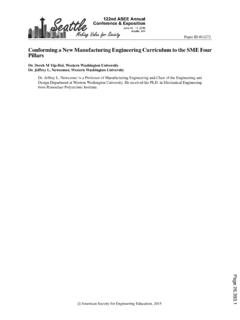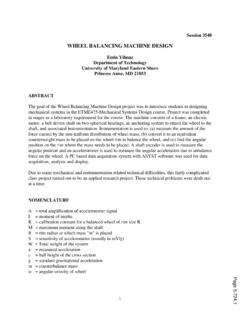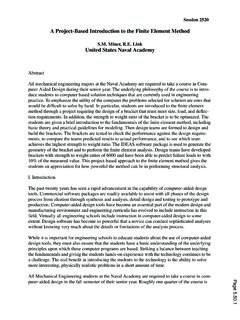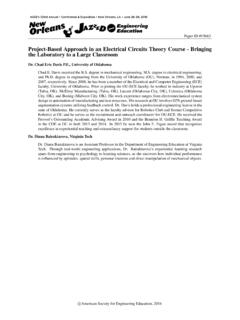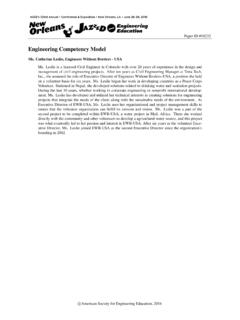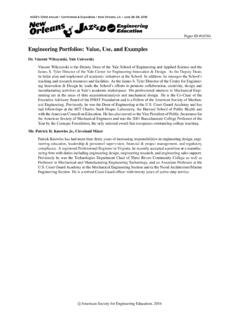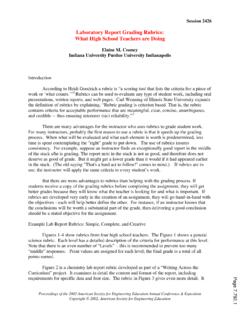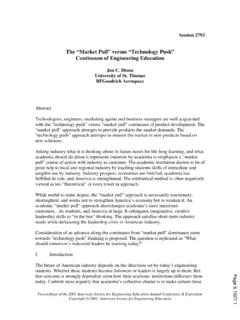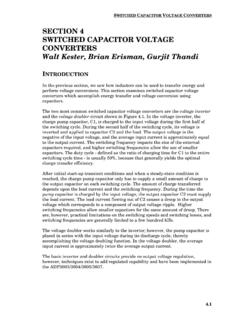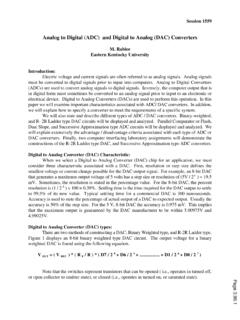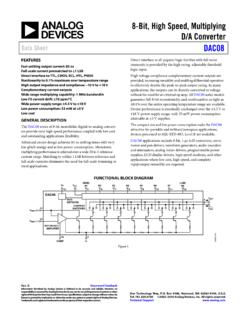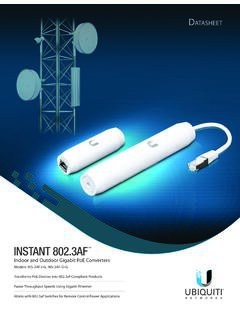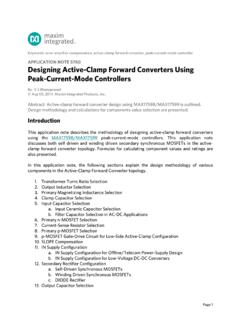Transcription of Parallel To Serial And Serial To Parallel Converters
1 Proceedings of the 2002 American Society for Engineering Education Annual Conference & Exposition Copyright 2002, American Society for Engineering Education Session 1532 Parallel -to- Serial and Serial -to- Parallel Converters Max Rabiee, , University of Cincinnati Abstract: Microprocessors (MPUs) on a computer motherboard communicate in a Parallel format with the memory system and support chips. The memory system consists of Read Only Memory (ROM), and Random Access Memory (RAM). The 8255 Programmable Peripheral Interface (PPI) is an example of such a support chip [1]. Microprocessors (MPUs) communicate in a Serial format with outside peripheral devices. Serial -to- Parallel and Parallel -to- Serial conversion must be performed to establish this communication.
2 A few examples of outside computer peripheral devices are the modem, the printer, and the CRT terminal. In Parallel communication format, all data bits are transferred at the same time through a computer data bus, while in Serial communication, bits are transferred through one data line in a pulse format. Parallel data must be converted to Serial data form prior to transmission to the outside peripheral device(s). The Serial data received by the computer from an outside peripheral device must be converted back to a Parallel format and then placed on the computer data bus [2]. The Parallel data on the computer data-bus is represented by either zero or five volts (0V or 5V). However, the Serial data, which is transmitted outside the computer, must be set to an industry standard voltage/current level.
3 These standards are designed to insure that the transmitted data is immune to outside electromechanical and electromagnetic noise interference. In this paper, we will describe the terms used in Serial communication systems. Then, we will describe a project in which a digital circuit is designed to convert the Parallel data to Serial format. Application specific chips are available to perform the task of Parallel -to- Serial and Serial -to- Parallel conversion. One example of such an application specific chip, is the INTEL 8251A [1], which is a Universal Synchronous/Asynchronous Receiver/Transmitter (USART) chip. This chip can be programmed to convert Parallel data to Serial and vice versa. It can also be programmed to either transmit or receive data in asynchronous or synchronous forms.
4 If the 8251A is programmed for asynchronous transmission, its framed data words must have at least one start bit, or possibly a one and a half, or two stop bits. In addition, the framed data words may be set to include parity bits. The 8251A is also programmed to set the Serial data transmission speed rate in bits per second. Page of the 2002 American Society for Engineering Education Annual Conference & Exposition Copyright 2002, American Society for Engineering Education Semiconductor chips similar to the INTEL 8251A are utilized by the computer motherboard to convert, receive, and transmit data for the microprocessor. We will also describe one of the popular Serial communication standard that is utilized in industry. This Serial communication protocol is used to protect the Serial data from distortion due to outside electrical noise pollution.
5 Students in a microprocessor interfacing class will learn how to program the 8251A chip and similar types of chips [2]. However, projects that encourage the students to design and build a data transmission system will motivate them to enjoy programming the microprocessor and its peripheral chips. The project in this paper will familiarize students with the integral working structure of chips that are used for Parallel -to- Serial conversions. Introduction: Within a computer system, microprocessors communicate in a Parallel format with their support chips ( , ROM, RAM, etc.). Outside devices, such as modems and printers are Serial devices. Therefore, Serial -to- Parallel and Parallel -to- Serial conversion must be accomplished. A typical 7-bit, ASCII (American Standard Code for Information Interchange) character, such as "E" could be transmitted in the asynchronous Serial form displayed in Figure 1[2].
6 Start D0 D1 D2 D3 D4 D5 D6 Parity Stop Stop Mark Space 0 1 0 1 0 0 0 1 1 1 1 Figure 1- Seven-bit Framed ASCII Serial Word for the Letter E In asynchronous communication there is no common clock between the transmitter and receiver. While for synchronous communication there must be a common clock connection between the transmitter and receiver. In synchronous transmission, after transmission of a few start bit signals, data is transferred continuously. Asynchronous communication is used more often than synchronous communication. In asynchronous Page of the 2002 American Society for Engineering Education Annual Conference & Exposition Copyright 2002, American Society for Engineering Education communication, Start and Stop bits must be added to the ASCII (American Standard Code for Information Interchange) data prior to transmission.
7 One (1), one and half ( ), or two (2) high pulses indicate the termination of word transmission. Sometimes a parity bit is also added to the data for utilizing the parity check process. Adding start, stop, and parity bits to the ASCII data is called framing the data. The transmitter will frame the ASCII word prior to transmission. The receiver will strip the frame bits ( , start, stop and parity bits), and save the ASCII word. A parity check can be used to detect the loss of one bit during the transmission. If the number of high bits in the transmitted word is even, the word has EVEN parity. If the number of high bits in the transmitted word is odd, the word has ODD parity. Prior to transmission, the communication system is set for EVEN, ODD, or NO parity check.
8 Parity bit is used to set the number of high bits to even or odd for the transmitted word. Then, the receiver will check to see if the parity setting is correct. Note that in Serial communication, the term mark indicates logic one (1) and the term space indicates logic zero (0). A low bit indicates the start of data transmission. The transmitted word displayed in Figure 1 has a one start bit (one Mark), and two stop bits (two Space). This transmitted word, has been set for EVEN Parity. Devices that are used to send or receive Serial data ( , modem) are called Data Communication Equipment (DCE). The terminals or computers that are sending or receiving data are refereed to as Data Terminal Equipment (DTE). In a Simplex communication system, data is transmitted in only one direction.
9 This means that data can either flow from the Data Communication Equipment (DCE) to Data Terminal Equipment (DTE) or vice versa. In a Half Duplex communication system data can be transmitted in both directions but not at the same time. This means that data can flow from the DTE to the DCE or vise versa but not simultaneously. In a Full Duplex communication system data can be transmitted in both directions simultaneously. This means that both the DTE and the DCE can transmit and receive at the same time. Parallel -to- Serial and Serial -to- Parallel conversions at the TTL (Transistor -Transistor Logic) level are carried out by support chips such as the 8251A. In the Transistor -Transistor Logic (TTL), the low level logic is between approximately 0 to , while the high level logic ranges between to There are three types of Serial -to- Parallel / Parallel -to- Serial converter chips; (1) Universal Synchronous Receiver/Transmitter (USRT), (2) Universal Asynchronous Receiver/Transmitter (UART), and (3) Universal Synchronous/Asynchronous Receiver/Transmitter (USART).
10 The 8251A is a USART and is capable of Full Duplex communication. Serial data in the TTL (Transistor / Transistor Logic) level cannot be transmitted due to the transmission line's capacitance. Transmission line capacitance will cause digital signals to be distorted. The Electronic Industrial Association (EIA) has set the standard for a RS232C (Recommended Standard 232C) plug compatibility between equipment made by different manufacturers. In the RS232 standard, logic zero (0) is represented by voltage between +3V and +25V, while logic one (1) can be anywhere Page of the 2002 American Society for Engineering Education Annual Conference & Exposition Copyright 2002, American Society for Engineering Education between -3V and -25V. Most RS232C microcomputer interfaces use +12V or +15V to represent a logic zero, and -12V or -15V to represent logic one level.


